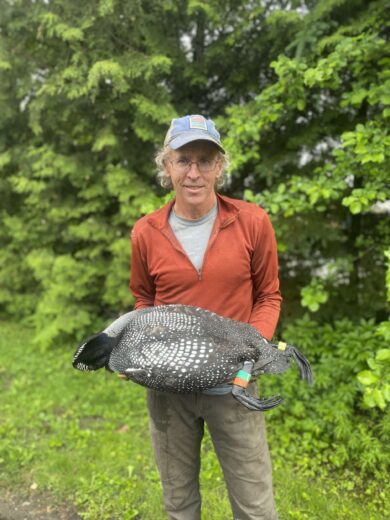Norwich, VT – Last month, the Vermont Center for Ecostudies (VCE) announced the death of Vermont’s oldest known loon, a 31-year-old male from Newark Pond. At the time, VCE Vermont Loon Conservation Project biologist Eric Hanson was awaiting results from an autopsy report, hoping it would shed some light on the loon’s cause of death and overall health. Hanson received the results last week, and they show the loon was in excellent health at the time of its death and displayed injuries consistent with blunt trauma.
The “Newark Pond Male” was examined by Dr. Mark Pokras from Tufts Veterinary School of Medicine. “Dr. Pokras and I thought this would be another lead poisoning case because the x-ray showed a sinker in the gizzard. And lead poisoning is the leading cause of loon mortality in the Northeast,” says Hanson. “However, when Dr. Pokras tested the loon for lead, the results were insignificant—lead did not kill this loon. The sinker was not lead. All signs point to a high-speed, one-sided impact, possibly caused by a motorboat hit.”
The Newark Pond Male’s advanced age was a testament to the success of loon conservation efforts in Vermont. When the loon was originally tagged by Hanson in 1998, loon populations across the Northeast were so low that the species was listed as Endangered in Vermont. Thanks to the hard work of Hanson, the Vermont Fish & Wildlife Department, community members, and countless others, loon populations recovered enough to be de-listed in 2005. Once a rare spectacle, loons now occupy many Vermont lakes and ponds, where they charm birders, watersport enthusiasts, and property owners alike with their showy plumage and haunting calls. In 2021, Vermont’s loons had their most productive year since the Vermont Loon Conservation Project began, with 109 nest attempts and 85 chicks surviving through August.
“Despite the success of the past few decades, loons still face many risks across their range,” Hanson says. “Vermont’s loons must regularly contend with fishing gear, predators, malaria (and other diseases), human disturbance at nest sites, and much more.”
The Newark Pond Male is a reminder of both conservation victories and the work that remains to protect the state’s loon populations. “It’s always sad when the death of a wild creature who has occupied space in our lives can potentially be attributed to human-caused activity,” says Hanson. “And this particular individual has been a striking presence for over 25 years.”
In general, boats colliding with loons are rare, with only nine total cases documented in the past 25 years. Most boat hits are unintentional; loons can pop up anywhere, just like deer darting in front of a moving car.
“I’m sure there have been hundreds of close calls, but loons can usually dive out of the way,” says Hanson. “However, as loons become more habituated to boat traffic, they might be less likely to dive.”
Although boat strikes play a small role in the big picture of threats to loons, boaters play an essential part in loon protection. When it comes to loon-safe boating, awareness is key. “It’s crucial that everyone add loons to the list of things to watch out for when on the water, along with swimmers and kayakers,” says Hanson. “If you see a loon in one part of the lake, avoid that area for a short time. However, like boaters, loons will frequently use the entire lake. Please remember to slow down when you see loons, especially adults with chicks. Chicks are poor divers up until six to seven weeks of age. For people, lakes are a playground. For animals, lakes are habitat they depend on for survival.”
Ultimately, Hanson and other loon biologists hope this incident will help raise awareness for boaters and other watersport enthusiasts’ vital role in loon conservation. A complete list of loon-safe tips for boaters is available on VCE’s website.
-30-
Images Available for Use:
Use of the provided image is protected by copyright and permitted only within stories about the content of this press release. Redistribution or any other use is prohibited without express written permission of the Vermont Center for Ecostudies or the copyright owner.

VCE loon biologist Eric Hanson holds the Newark Pond Male. Photo credit: Eloise Girard
